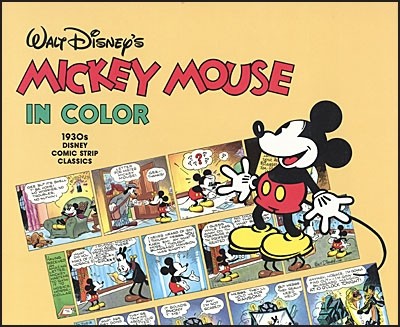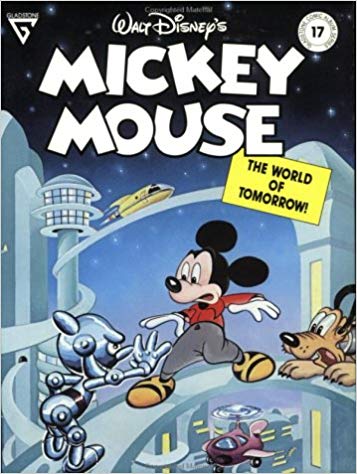Walt Disney’s Mickey Mouse in Color

By Geoffrey Blum, Thomas Andrae, Floyd Gottfredson, Carl Barks & various: produced by Another Rainbow Publishing Inc. (Pantheon Books 1988)
ISBN: 978-0-39457-519-3 (HB)
Created by Walt Disney and Ub Iwerks, Mickey Mouse was first seen – if not heard – in the silent cartoon Plane Crazy. The animated short fared poorly in a May 1928 test screening and was promptly shelved.
That’s why most people cite Steamboat Willie – the fourth Mickey feature to be completed – as the debut of the mascot mouse and his co-star and paramour Minnie Mouse. It was the first to be nationally distributed, as well as the first animated feature with synchronised sound.
The film’s astounding success led to the subsequent rapid release of its fully completed predecessors Plane Crazy, The Gallopin’ Gaucho and The Barn Dance, once they too had been given new-fangled soundtracks.
From those timid beginnings grew an immense fantasy empire, but film was not the only way Disney conquered hearts and minds. With Mickey a certified solid gold sensation, the mighty mouse was considered a hot property and soon moved in on America’s most powerful and pervasive entertainment medium: comic strips…
Floyd Gottfredson was a cartooning pathfinder who started out as just another warm body in the Disney Studio animation factory who slipped sideways into graphic narrative and evolved into a pictorial narrative ground-breaker as influential as George Herriman, Winsor McCay or Elzie Segar. Gottfredson’s Mickey Mouse entertained millions of eagerly enthralled readers and shaped the very way comics worked.
He took a wild and anarchic animated rodent from slap-stick beginnings, via some of the earliest adventure continuities in comics history: transforming a feisty everyman underdog – or rather mouse – into a crimebusting detective, explorer, lover, aviator or cowboy: the quintessential two-fisted hero whenever necessity demanded.
In later years, as tastes – and syndicate policy – changed, Gottfredson steered that self-same wandering warrior into a more sedate, gently suburbanised lifestyle via crafty sitcom gags suited to a newly middle-class America: a fifty-year career generating some of the most engrossing continuities the comics industry has ever enjoyed.
Arthur Floyd Gottfredson was born in 1905 in Kaysville, Utah, one of eight siblings born to a Mormon family of Danish extraction. Injured in a youthful hunting accident, Floyd whiled away a long recuperation drawing and studying cartoon correspondence courses, and by the 1920s had turned professional, selling cartoons and commercial art to local trade magazines and Big City newspaper the Salt Lake City Telegram.
In 1928 he and his wife moved to California and, after a shaky start, found work in April 1929 as an in-betweener at the burgeoning Walt Disney Studios.
Just as the Great Depression hit, he was personally asked by Disney to take over newborn but ailing newspaper strip Mickey Mouse.
Gottfredson would plot, draw and frequently script the strip for the next five decades: an incredible accomplishment by of one of comics’ most gifted exponents.
Veteran animator Ub Iwerks had initiated the print feature with Disney himself contributing, before artist Win Smith was brought in. The nascent strip was plagued with problems and young Gottfredson was only supposed to pitch in until a regular creator could be found.
His first effort saw print on May 5th 1930 (Floyd’s 25th birthday) and just kept going; an uninterrupted run over the next half century.
On January 17th 1932, Gottfredson created the first colour Sunday page, which he also handled until his retirement. In the beginning he did everything, but in 1934 Gottfredson relinquished the scripting, preferring plotting and illustrating the adventures to playing about with dialogue.
His eventual collaborating wordsmiths included Ted Osborne, Merrill De Maris, Dick Shaw, Bill Walsh, Roy Williams and Del Connell. At the start and in the manner of a filmic studio system Floyd briefly used inkers such as Ted Thwaites, Earl Duvall and Al Taliaferro, but by 1943 had taken on full art chores.
Mickey Mouse in Color is a lavish hardback compendium reprinting some of the most noteworthy early strips with fascinating text and feature articles – including interviews with Gottfredson – but the real gold is the glorious strips.
A mix of Sunday page yarns comprising ‘Rumplewatt the Giant (1934)’, ‘Dr. Oofgay’s Secret Serum (1934)’, the magnificent and mesmerising ‘Case of the Vanishing Coats (1935)’ and a whimsical ‘Robin Hood Adventure (1936)’ are, although superlative, mere appetisers.
The best stories and biggest laughs come with the rollickin’ comedy thrill-ride serials ‘Blaggard Castle (1932)’, ‘Pluto and the Dogcatcher (1933)’, ‘The Mail Pilot (1933)’ and the astoundingly entertaining and legendary ‘Mickey Mouse Outwits the Phantom Blot (1939)’.
Consistency is as rare as longevity in today’s comic market-place, and the sheer volume of quality work produced by Gottfredson remained unseen and unsung for generations until Fantagraphics released a complete library of the Mouse’s US-crafted strip adventures. We’ll be covering those in greater detail over the months to come but until then, books like this comprehensive primer (still readily available through online retailers), should be welcomed, cherished, and most importantly, shared.
© 1988 The Walt Disney Company. All Rights Reserved.
Walt Disney’s Mickey Mouse in The World of Tomorrow – Gladstone Comic Album #17

By Floyd Gottfredson, Bill Walsh & Dick Moores (Gladstone
ISBN: 978-0-94459-917-4
Floyd Gottfredson’s influence on graphic narrative is inestimable: he was one of the very first to move from daily gags to continuity and extend adventures, created Mickey’s nephews, pioneered team-ups and invented some of the first “super-villains†in the business.
In 1955 – by which time Mickey and his fellow pantheon stablemates were mainstays of comics in dozens of countries – Disney killed the continuities; dictating that henceforth strips would only contain one-off gag strips. Gottfredson adapted easily, working on until retirement in 1975. His last daily appeared on November 15th and the final Sunday on September 19th 1976.
In this still-easy-to-find oversized paperback album from the 1980s, Gottfredson’s middle period of cartoon brilliance comes to the fore and opens with an uplifting and supremely funny saga originally running from July 31st to November 11th 1944 and designed to counteract the woes of a war-weary world…
After D-Day and the Allied push into Occupied Europe, the home-front morale machine began pumping out conceptions of what the liberated happy future would be like. A strip as popular as Mickey Mouse couldn’t help but join the melee and new scripter Bill Walsh produced a delightfully surreal, tongue-in-cheek parable in ‘The World of Tomorrow’: full of brilliant, incisive sight-gags and startling whimsy whilst pitting the Mouse against arch-enemy Peg Leg Pete, who was in extreme danger of conquering the entire planet, using the double-edged advances in modern science!
Walsh, Gottfredson & inker Dick Moores also produced the remainder of this delightful book for kids of all ages, which comprise a dozen one-off gag dailies from 1944 and 1945, plus a cracking sea yarn ‘The Pirate Ghost Ship’ (first serialised from April 17th to July 15th 1944) which found Mickey and faithful hound Pluto searching for treasure, defying black magic and battling sinister buccaneers in a rollicking rollercoaster of fun and frights.
Walsh (September 30th 1913 – January 27th 1975) loved working on the strip and scripted it until 1964 when his increasingly successful film career forced him to give it up.
Like all Disney comics creators these stalwarts worked in utter anonymity, but thanks to the efforts of devout fans efforts were eventually revealed and due acclaim accorded. Gottfredson died in July 1986 and Walsh did achieve a modicum of fame in his lifetime as producer of Disney’s Davy Crockett movies, and as writer/producer of The (original) Absent-Minded Professor, Son of Flubber, That Darn Cat!, The Love Bug, Bedknobs and Broomsticks and many others.
He was Oscarâ„¢ nominated for his Mary Poppins screenplay.
Even in these modern, accepting times anthropomorphic comics are still often derided as kids’ stuff – and indeed there’s nothing here a child wouldn’t adore – but these magical works were produced for consumers of ALL AGES and the sheer quality of Gottfredson and Walsh’s work is astounding to behold.
That so much of it has remained unseen and unsung is a genuine scandal. Thankfully most of the Gladstone Mickey Mouse albums are still readily available and we now have the scholarly and comprehensive Gottfredson Mickey Mouse Archives so you have no reason not to indulge in some of the greatest comic tails of all time.
© 1989, 1945, 1944 The Walt Disney Company. All Rights Reserved.
